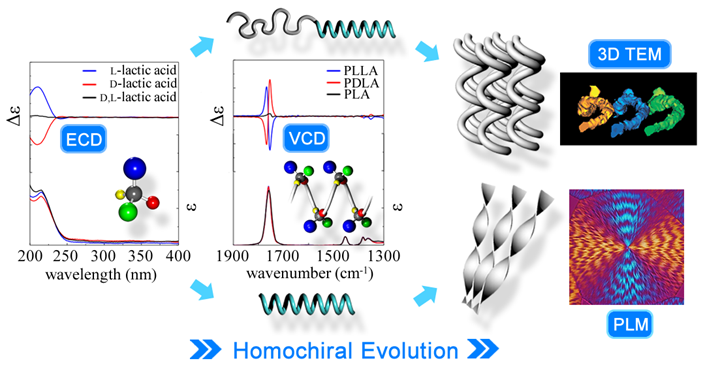Title: Universal Effects of Chirality on the Self-Assembly of Block Copolymers and Polymers
Speaker: Prof. Rong-Ming Ho, Department of Chemical Engineering, National Tsing Hua University, Hsinchu 30013
Date: 2019-04-18 10:00 AM
Location: Room 202, Lujiaxi Building
Abstract:
Here, we aim to investigate the universal effects of chirality on the self-assembly of chiral block copolymers (BCPs*). Poly(cyclohexylglycolide) (PCG)-based BCPs* (i.e., poly(benzyl methacrylate)-b-poly(D-cyclohexylglycolide) (PBnMA-PDCG) and PBnMA-b-poly(L-cyclohexyl glycolide) (PBnMA-PLCG)) have been synthesized for self-assembly to give systematic comparisons with polylactide (PLA)-based BCPs* with respect to the chirality effects on BCP self-assembly. Opposite handedness of PCG helical chains in the enantiomeric BCPs* were identified by the vibrational circular dichroism (VCD) results of carbonyl group (C=O) stretching due to intra-chain chiral interactions of constituted chiral entities. By taking advantage of inter-chain chiral interactions as evidenced by the VCD results of C-O-C vibration, the self-assembly of the PCG-based BCP* gave the formation of helical phase (H*) with preferential handedness of helical microdomain as recognized by transmission electron microscopy tomography (3D TEM), suggesting the chirality effects on BCP self-assembly and the homochiral evolution from molecular to hierarchical scales. With higher twisting power than that of PLA-based BCPs*, the thermodynamic stability of forming H* in the PCG-based BCPs* can be significantly enhanced. The observed phase behaviors of the PCG-based BCP*s are in line with theoretical prediction based on chiral orientational self-consistent field theory at which the chiral PCG behaves like mesogenic liquid crystal as predicted by theory and evidenced by the appearance of VCD signals of the C-O-C vibration. For chiral polylactides, twisted lamellae in crystalline banded spherulite could be formed by dense packing scheme and effective interactions upon helical chains from self-assembly. The handedness of the twisted lamella can be determined by using rotation experiment of polarized light microscopy (PLM). Similar to the self-assembly of BCPs*, the examined results suggest the homochiral evolution in the crystallized chiral polylactides. The suggested methodologies for the understanding of the mechanisms of the chirality transfer at different length scales provide the approaches to give supplementary information for disclosing the mysteries of the homochiral evolution from molecular level.

Figure. Homochiral evolution from the self-assembly of chiral and block copolymers and polymers.
(Ho, R. M. et al. Acc. Chem. Res. 2017, 50, 1011.)
Biography:
Name: Rong-Ming Ho
Affiliation: Department of Chemical Engineering National Tsing Hua University
Position: Chairman and NTHU Chair Professor
Address: No. 101, Section 2, Kuang-Fu Road, Hsinchu,Taiwan 30013, R.O.C.
E-mail: rmho@mx.nthu.edu.tw
Education:
1991/09- 1995/05 Ph.D. Institute of Polymer Science, University of Akron, USA
Academic Appointment:
Present NTHU Chair Professor Department of Chemical Engineering,National Tsing Hua University, Hsinchu, Taiwan
2006 – 2009 Professor Department of Chemical Engineering National Tsing Hua University, Hsinchu, Taiwan
2002 – 2006 Associate Professor Department of Chemical Engineering,National Tsing Hua University, Hsinchu, Taiwan
Research Interests:
Research focuses in recent ten years:
Self-assembly of chiral polymers and block copolymers
Fabrication of well-ordered nanohybrids and nanoporous materials
Nanopatterning Technologies from Bottom-up Methods
Awards:
Outstanding Research Award, Polymer Society of Taiwan, 2015
Fellow of American Physical Society, 2014
Outstanding Research Award, Ministry of Science and Technology of Taiwan, 2013
Member of Editorial Advisory Board for Macromolecules 2014-2016
Member of Editorial Advisory Board for ACS Macro Letters 2014-2016
DPS Outstanding Alumni Award, University of Akron, 2012
Outstanding Research Award, National Science Council of Taiwan, 2006